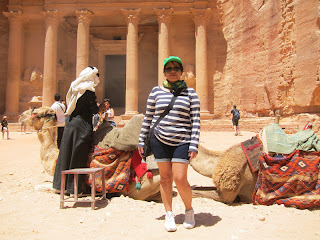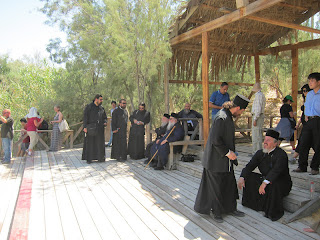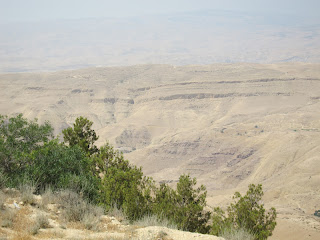Jordan.
The two movies were either filmed in entirety in the southern desert in Jordan (Wadi Rum region) or in part in the famed lost city of Petra.
As for the Biblical references these lands shared much with what is now Israel.
We were to take a two hour flight from Jeddah to Amman (capital of Jordan) to spend five days in this relatively small country, which is rich in geographical features (deserts, mountains) and history, being at the crossroads of many ancient trading routes, as well as the site of many biblical events. Politically today Jordon can also be seen as a bit of a buffer country, having Israel, Syria, Iraq, and Saudi Arabia on its various borders, clearly some of the present "hot zones" in the region.
For once we did not have to get up for a very early morning flight leaving from Jeddah (as would be the case flying to Europe or North America).
A view of the Northern part of Jeddah with the inlet from the Red Sea where we usually leave from on our dive boat trips and the area for many of the private beaches.
Flying over the Southern Jordanian desert. The "shadow" seen on the landscape is actually a farm using local irrigation. There were a number of these sites scattered in the desert. Lawrence of Arabia traversed this region. So did the Crusaders in their quest to conquer the Holy Lands.
Our first evening in Amman we visited Books@Cafe, a recommendation, a combination bookshop, bar, and restaurant with a nice roof top patio view of the old city.
Of course the requisite Guinness was required after the journey from the Magic Kingdom. Although the predominant religion is Islam, it is a secular country with Christians and Jews also living peacefully here. Jordan also has a treaty with Israel, allowing easy travel between the two countries.
Our driver, which we hired to travel around the country, was an Arab Palestinian, who was Christian, and also had dual Jordanian and American passports!
Although a city of over a million people Amman is fairly quiet, and not considered a place that has the same degree of interesting sites to visit as many of the other cities in the region. However despite this Amman has ancient roots, being the site of the Biblical Rabbath Ammon mentioned in Genesis. It has subsequently had Roman and Islamic influences.
Rainbow Street (below), in the old town, is slowly developing as a place to stroll in the evenings.
Although Amman has limited attractions itself it is a good base to do side trips from as the country is relatively small.
From Amman we drove about three hours South, through the desert then back to higher elevations to visit the famed "lost city" rediscovered by Europeans in the early 1800's (sitting in ambandonement for nearly 2000 years).
Hollywood does make its impact for tourists. Yes Harrison Ford as the archeologist in "Raiders of the Lost Arc", as he was seen riding on horse into the lost city of Petra. Petra is an ancient site, probably the site of Sela, the Edomite capital sited in the Old Testament, but more famous today for the magnificent structues built by the Nabateans (pre Roman and pre Christian) when they controlled the trade routes from the Arabian peninsula as well as the East-West travelling caravans (part of the old Silk Road?).
The walk in from the main entrance gate was quite long, but magnificent, despite the heat and liberal use of our water bottles on route. Although one could pay to ride in on donkeys, horses, carriages, or even a camel we decided to hike in on our two feet. This is not a site to rush, pictures not doing justice to the awe one feels in wandering through this amazing place, clearly a "bucket list" experience.
The above (lowest) image shows the entrance to the "Siq", the narrow entranceway into the city of Petra itself. It is a long steep walled passage known only to the local Bedouins until rediscovered by a European, and of course Indiana Jones, after nearly two thousand years of hiding.
Coming out of the "Siq" (lowest image above) to see the "Treasury" in full view was an amazing experience.
The site of the ancient city was huge, requiring many hours of walking to do it full justice - unfortunately our time was more limited. The experience was that of standing in a semi mythical location.
After Petra a three hour drive back to Amman, through desert landscape.
The beer went down well after all that heat. We were next to change gears and experience some of the Holy Land itself.
The Dead Sea separates Jordan from Israel, each sharing a side. It is clearly the saltiest body of water on earth, with the high temperatures here and limited feeding of water from the Jordan River. It sits well below sea level being one of the lowest points on the earth's surface. Due to its high salinity no fish can survive here. Also as a result of its high viscosity (high salinity) there is also no boat travel on these waters. However also due to the salinity buoyancy is the highest of any body of water on earth. Its mud is also thought to be therapeutic!
No life jackets are needed to float here. However people do drown here due to its extremely high buoyancy, therefore unless a strong swimmer it is not recommended to swim on one's stomach. Why? Because lying face down the buoyancy lifts the legs so high that the face is pushed underwater! As a result I had to help Joy roll over as she had difficulty getting her legs below water to spin around.
The Jordan River, of Biblical fame, feeds the Dead Sea - there is no outlet. Unfortunately this famous river has been reduced to a stream as a result of Israeli diversion of some of the river upstream for irrigation purposes.
We visit the reputed Baptism site where St. John the Baptist Christened Jesus in the River Jordan. Note its levels are lower than the original river due to the upstream diversion in Israel for irrigation purposes - politics!
This view is from the East Bank of the Jordan River (Jordan) looking across to the West Bank (Israel) - yes you can almost reach out and touch the people on the other side, in a different country. The pool of water in the center is symbolic (Holy) and used for religious purposes - Joy dipped some small Crosses here. On the other side whole body immersion Christenings were taking place.
We now took a journey into the nearby mountains to visit Mt. Nebo, the location where it is suggested that Moses saw the Promised Land and where he was subsequently buried.
Our journey took us next to Madaba, an ancient small city known in the Bible as Medba, and visited the Greek Orthodox Church of St. George.
Madaba's height of splendor was during the early Christian era, which under the Byzantines became a major centre of mosaic workers. On the floor of this old church is the oldest (mosaic) map of Palestine depicted for the benefit of pilgrims visiting the Holy Land.
This part of our journey will come to a close - next episode a different aspect of the trip to Jordan. With the exception of Petra the main focus of this part of the Blog was visiting the Biblical parts of Jordan. Aside from the sheep and the goats seen everywhere, there are many olive trees and scattered fig trees. These have been part of the landscape from ancient times. At this part of the trip back to Amman our driver stops to pick some figs.
The next episode featuring different aspects of this trip to follow - clearly a busy vacation, a lot to do in five days.
...

























































































No comments:
Post a Comment